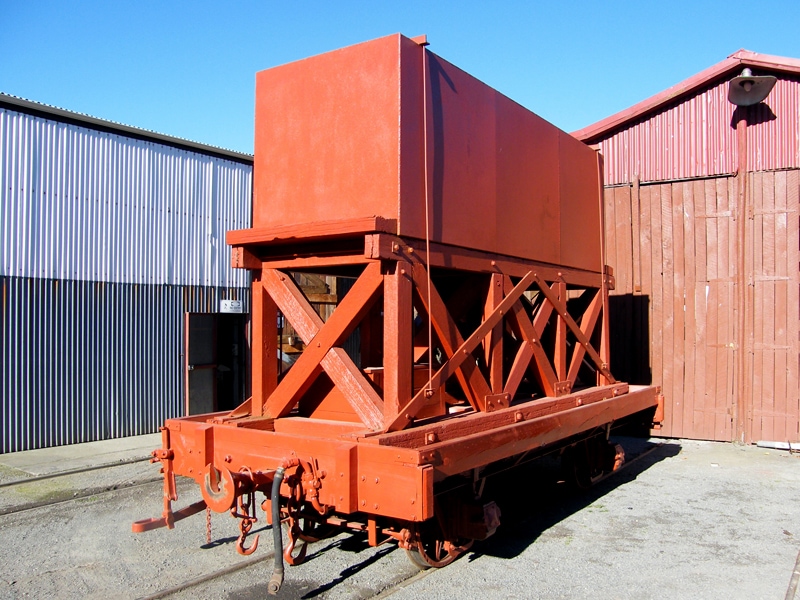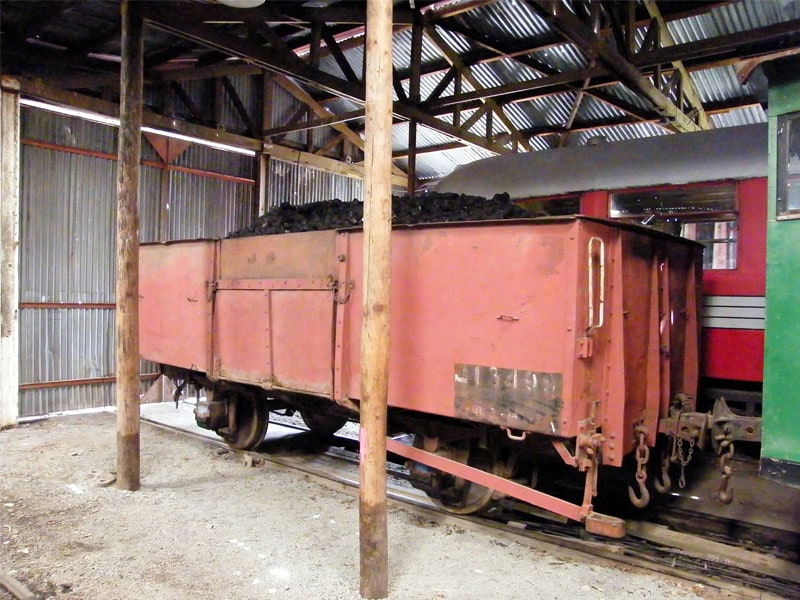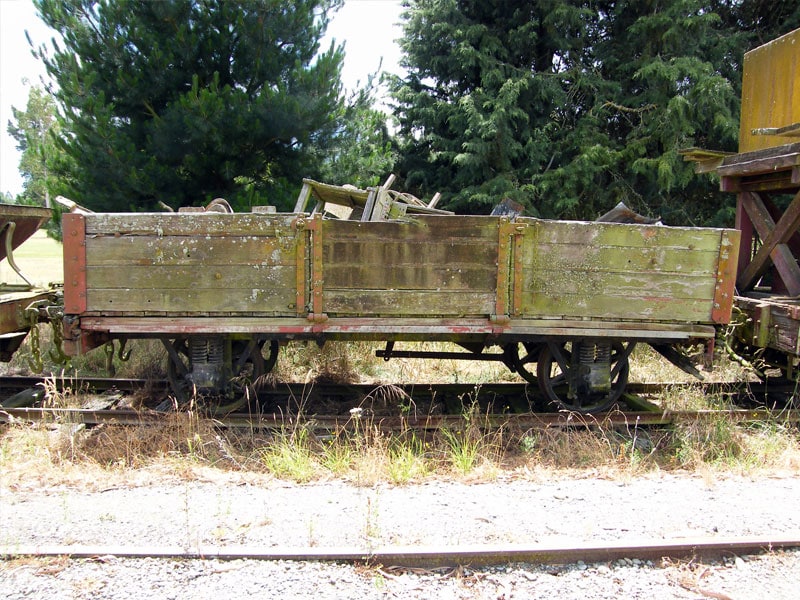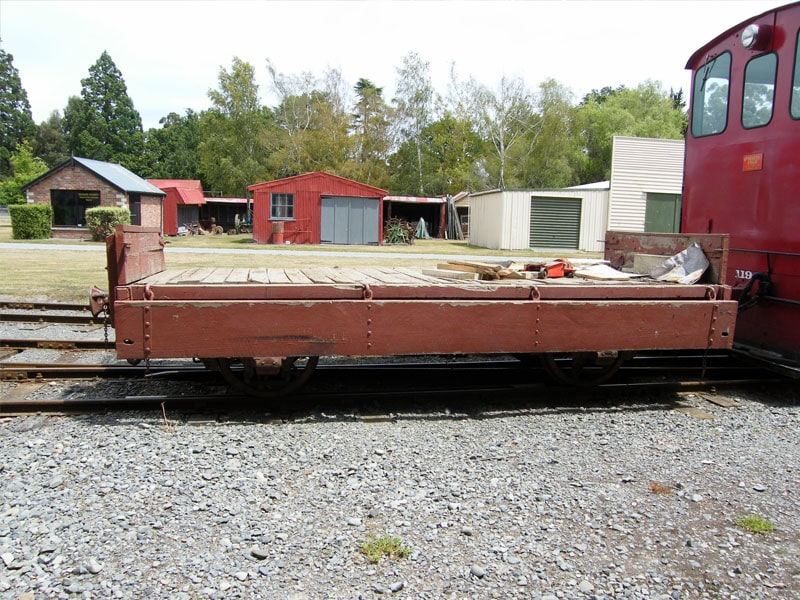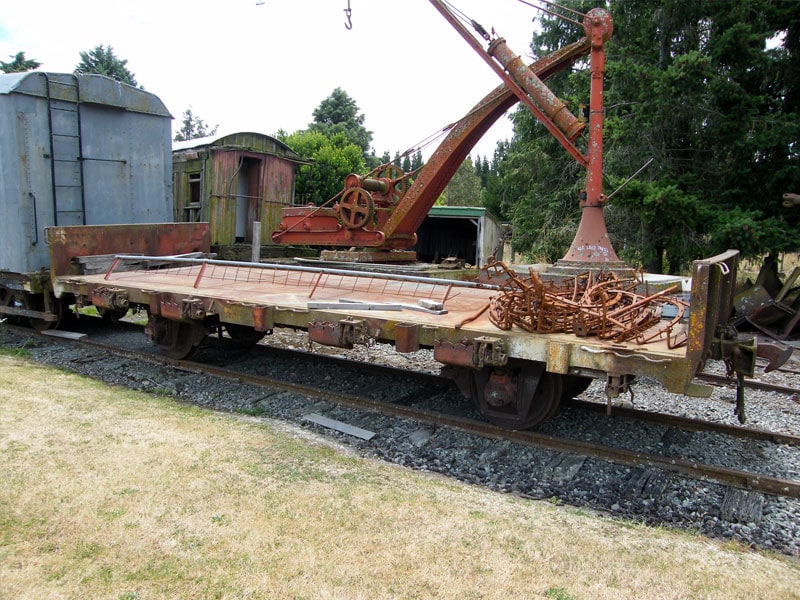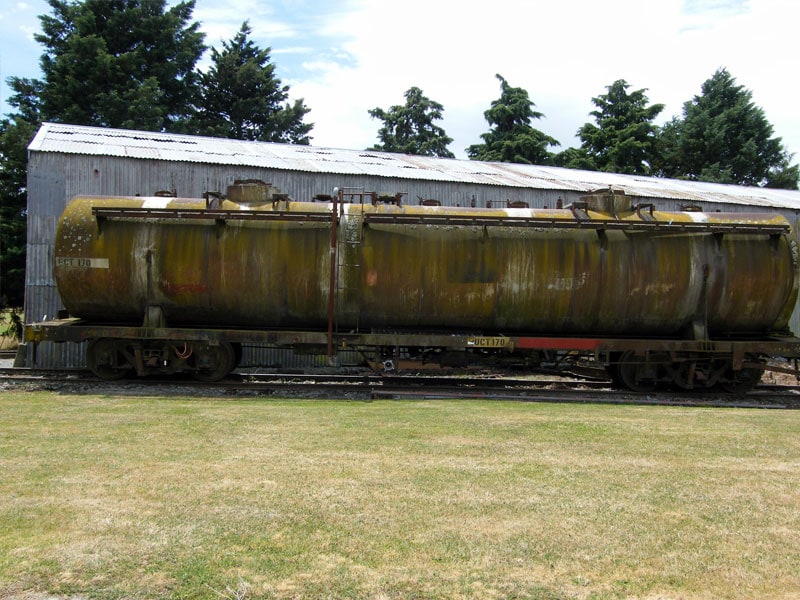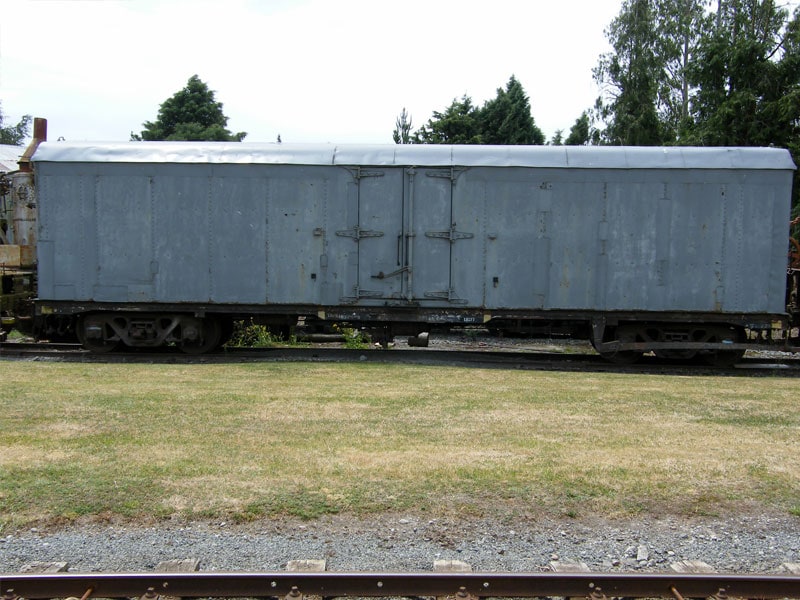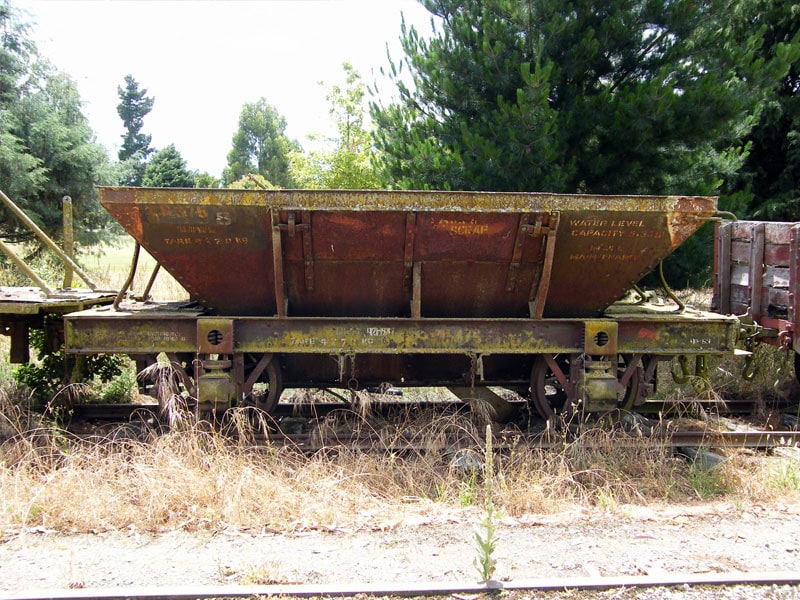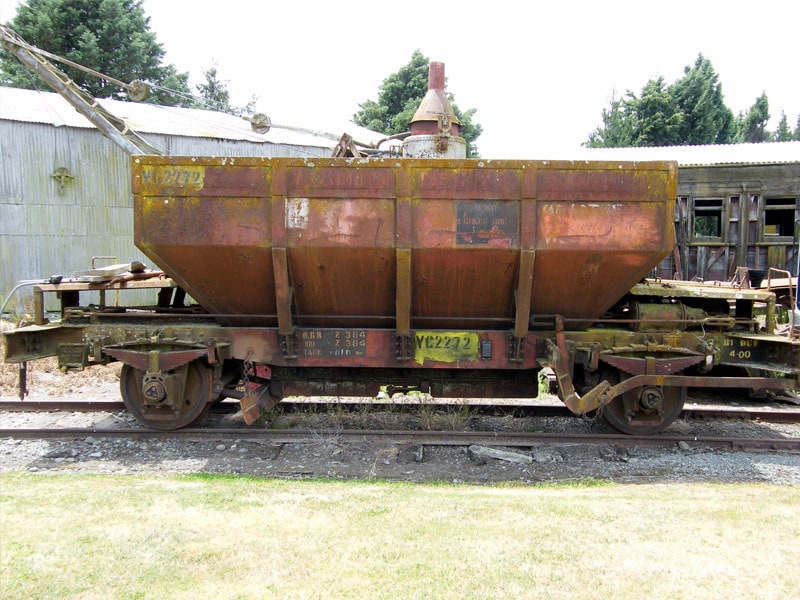E Class Water Wagon
E 852 (Formally N 212)
E 852 is the last survivior of a once numerous class of M and N wagon conversions.
History – As known, prior to acquisition
E 852 probably began its life in the 1880’s as an N wagon before acquiring the number N 212 during the renumbering of 1890.
Very little is known of the wagons usage in this period but it was likely in general traffic right through to 1938 when records indicate it was converted from an N wagon to the tank wagon seen today. It was at this time that it acquired the number E 852.
After conversion the tank ran in non-revenue service attached to the Mt Somers/Springburn branch line and appears to have been designated a ‘Loco Water Wagon’ – water tanks at the top end of the branch and at Punawai did tend to suffer from drought so it is likely the tank was used for refilling tenders or tanks of engines in the summer months, after being brought up from Ashburton. Some of The Plains’ members recall a similar tank being used for railway house water supplies as well, so the tank was probably dual purpose.
In later years the tank was attached to the crane group based in Christchurch before finding itself parked up at Linwood. The story goes that the Shed Foreman was sick of the sight of it and so it ended up at The Plains Railway in November of 1974, ironically back on the remains of the branch it once faithfully served.
History – After acquisition by The Plains Railway
E 852 was used by The Plains Railway for many years prior to being parked up at some time in the early 1990’s. The Plains Railway used it for trimming lineside trees and as such the tank was fitted with ‘catwalks’ around the outside. The Railway also used it for watering crops being grown in the railways neighbouring paddocks.
The Restoration
In January 2011, with the impending 40th Anniversary of the Society, a decision was made to bring into service as many of the Societies freight/non-revenue wagons as possible. E 852 was one of the wagons recovered from the sidings and long grass behind The Plains’ carriage shed and over the following weeks it was thoroughly cleaned to enable an inspection for ‘rail worthiness’ to be carried out.
The inspection soon revealed that while appearing to be in a moderate condition some work would be required before the wagon could run, namely the deck of the wagon had rotted through leaving the tank precariously perched upon the remains of the timber.
After approval by the committee, stripping down of the wagon began in earnest, with the tank being lifted off allowing the wagon chassis to be worked on. After the removal of the remains of the deck timbers it was revealed that the headstocks and interior wooden framing was in very poor condition once the exterior had been penetrated. This resulted in the need to completely rebuild the chassis, keeping only the longitudinal steel beams at the outside edges of the chassis.
The steel work – including wheels, axle boxes and brake gear – was sandblasted to remove all trace of the years of railways coats of paint, dirt and grime. One the sandblasting was completed work began in earnest in replacing the timberwork. After discussion with the local sawmill it was decided to use pine for the replacement timbers, not a hard wood – the miller believed he had suitably dense pine that would provide plenty strong enough.
After around two months of drilling, cutting and shaping the new interior timbers were at last ready to be attached to the framework and the wagon began to look once more like a wagon. The drawgear and brake rigging were reattached and the wagon was at last ready to receive the new decking that the whole process had been started to replace. On the 17th of September, with just over a month to go until the anniversary, the wagon emerged from the workshops for painting, looking as it must have done prior to having the tank fitted in 1938 – just like a long wheelbase N wagon.
While the wagon chassis was being restored the tank and its frame hadn’t been forgotten about, the tank receiving some minor repair work – mainly the fitting of a new lid/hatch on the top. The framework that supports the tank was sanded and primed ready for refitting to the wagon.
The day of the big refit arrived on the 1st of October and with a hand from a Hi-Ab the tank was lifted and placed back onto the wagon, which instantly began to look like itself once more. Positioning the tank ‘just right’ on the chassis proved to be a challenge as in order to lift the tank and frame without it all coming apart the lifting strops had had to be positioned under the frame itself, lots of helping hands overcame the issue at last and the wagon was rolled back into the shed to have the tank frame attached to the wagon chassis.
With the Anniversary Weekend fast approaching, the Tank was at last painted on October 15 – only a week before it was to take its place in the various mixed and works trains run over the Anniversary Weekend.
Before it could enter service the wagon was brake tested and was found to require a new brake shoe, this was replaced and the wagon was pushed into service just in time for the anniversary – after 3 days worth of running which included a blown brakehose on the Railfans day – the wagon was found to be running a bearing. This was attributed to the tank removal and replacement, which had seen the wagon lifted up off the rails at one point. After being jacked up and having the bearing replaced, however, the wagon has presented little issue and is now often seen tucked in behind the loco and ahead of the cars on Running Days at The Plains, as a point of local interest.
The FRONZ Award – Goods or Service Wagon (2012)
E 852 was entered in the 2012 FRONZ (Federation of Rail Organisations of New Zealand) annual awards for Goods or Service Vehicle restoration. Around the country various heritage railways have restored items that are then entered into their relevant categories to be judge by the FRONZ panel.
We were happy to receive the award, made even more special by the fact that this was the first time The Plains Railway had entered the category.
La-4a Steel Highside Wagon
Numbered 13498 this wagon is of the type La-4a, which is quite rare in preservation with only two others known to be preserved. La 13498 was built by Metropolitan Cammell in the United Kingdom and entered service in 1922.
The La-4a differs from the La-4 in regards to its axle box springing, the La-4a using leaf-springs while the La-4 has coil springs. The La-4 and La-4a wagons do not have full-width headstocks, making them stand out from their siblings quite noticeably.
The La class, with its numerous sub-types, was once one of the most abundant wagon classes on the New Zealand Railways system, being used for carting everything from Coal and Lime to Timber, Wool Bales and anything else that could be either lifted in or would fit through the side drop doors.
Our La-4a steel high-sided wagon is in a serviceable condition but is mainly used for the storage of our locomotive coal, meaning it is often kept hidden away in one of our sheds.
Lb Wooden Highside Wagon
The Lb class of wooden high-side wagons originally appeared in the late 1800’s for the cartage of a variety of items.
Our Lb wagon is number 9579 and is of almost entirely wooden construction, even having a wooden frame. From all appearances, the wagon was never fitted with air brakes, or even with a piped air supply (having no air brakes, but being able to carry air to the next wagon in the train) and so it is likely that this wagon was withdrawn from service pre-1915.
Lb 9579 was used extensively in the eartly years of The Plains Railway as an additional means of carrying passengers, but currently stored out of service.
M Wooden Lowside Wagon
The M class of wooden low-side wagon was used for the conveyance of many types of goods, from stacked timber to automobiles and tractors.
Our M wagon is number 173 (TMS: M360) and is used primarily for carting our generator, air compressor and track tools on track-work trains. However, it is also sometimes used as a ‘runner’ wagon (a wagon used to space locomotives apart, or from their train for weight or comfort purposes) on Running Days between Dubs ‘A’ 64 and the carriages.
NAK Steel Flat-Deck Wagon
The NAK class of wagon was introduced to carry small 20foot containers as well as other loads once carried by smaller, older wooden wagons of the classes M and N.
Our NAK is number 66 (TMS: NAK6672) and can sometimes be seen in use on Running Days.
UCT Bulk Tallow Tank Wagon
The UCT class of wagon was introduced in 1965 for the transport of Tallow from freezing works. The wagons were fitted with steam heating connections to allow steam locomotives to provide steam to the wagon to stop the tallow solidifying while in transit.
Our UCT wagon is number 1603 (TMS: UCT170)and is on long-term lease to us from The Rail Heritage Trust of New Zealand. UCT1603 is the only UCT class wagon to be preserved and there is only one other of the class known to survive, used as a fire water wagon at the Picton Ferry Terminal.
UCT1603 can sometimes be seen in use at The Plains Railway on Running Days.
V Insulated Meat Wagon
Numbered 76, our V class wagon dates from 1904 and was used for the transportation of meat from freezing works around the country.
V 76 was withdrawn from service in the mid 1970’s and purchased by Ravensdown Fertiliser, Tinwald where it has lved behind their buildings as a store for many years.
In 2014 Ravensdown gifted the wagon to The Plains Railway for preservation.
Long term plans include fitting bogies, of which we have in storage, and a few other bits and pieces to enable the wagon to become a runner once more. Until then its likely to see use as a potato shed, which being insulated it is ideal for, following the loss of our usual potato shed in early 2015.
VS Chilled Box Wagon
The VS is a type of box wagon used for the transportation of chilled meats introduced in 1958. Our VS is number 863 (TMS: VS898) and was built by Commonwealth Engineering, Australia.
The VS class proved problematic from early on, with rust setting into the body work due to the type of steel Commonwealth Engineering had constructed the wagons from. This lead to a lifetime of patching the steel and the withdrawal of the majority of the class in the 1970’s.
Our VS wagon arrived in December 1979 containing a large number of Vulcan Railcar spares. It is now used for storage of various locomotive spares and is now kept in undercover storage.
Yb Ballast Wagon
Yb wagons were used for the discharging of ballast (the small stones used to hold railway lines in place).
There were many types of Yb, and ours is a Yb-3 (The -3 designates that the wagon has been built to the third version of the plan). Our Yb is number 138 (TMS: YB375) and likely dates from the early to mid 1900’s.
Yb 138 is in a serviceable condition and can sometimes be seen running on our train on Running Days.
YC Ballast Wagon
Like the Yb, YC wagons were used for the discharging of ballast – in fact the YC class can be considered a larger, newer replacement for the Yb. Our YC wagon is numbered 890 (TMS: YC2272) and was last used in the Wellington Region by New Zealand Railways.
YC 890 was built by the New Zealand Railways Addington Workshops, in Christchurch, in 1961.
YC 890 is owned by the Rail Heritage Trust of New Zealand and is on long term lease to us at The Plains Railway.
The YC wagon in a serviceable condition and can sometimes be seen running on our train on Running Days.

